You’ll need at least a 100m water resistance rating to keep your watch safe while swimming, as lower ratings like 30m or 50m can’t handle the dynamic pressures created by arm movements and water turbulence. For serious swimming or ocean activities, you should consider a 200m rating for extra protection against unpredictable water forces. A screw-down crown design adds another layer of security by preventing accidental water entry during vigorous swimming sessions, giving you dual assurance beyond the basic rating alone.
Understanding Water Resistance Ratings for Swimming Activities
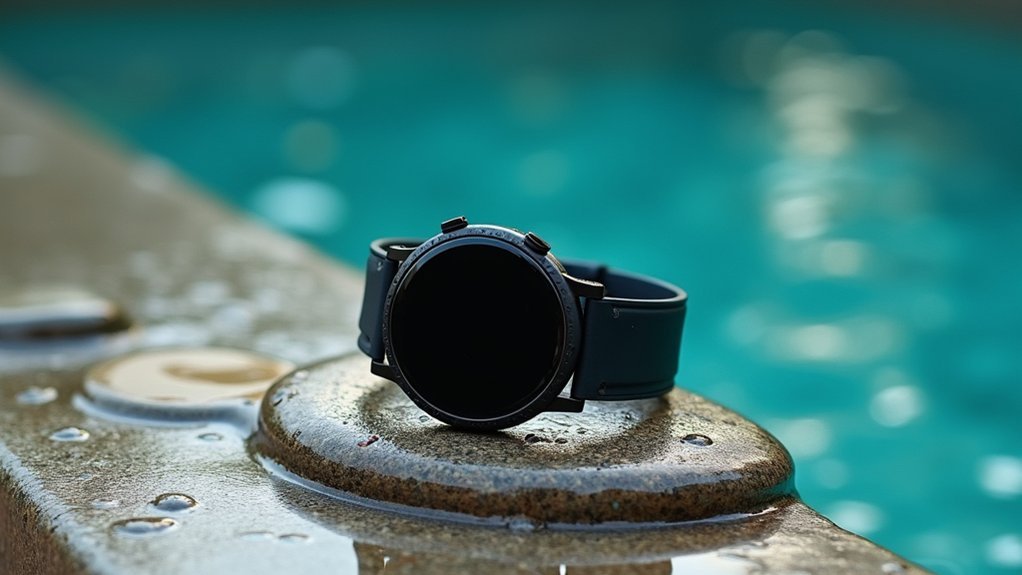
When you’re shopping for a swimming watch, understanding water resistance ratings becomes essential since these numbers determine whether your timepiece can handle aquatic activities.
These ratings indicate pressure tolerance—higher numbers mean more pressure before leaks occur. You’ll see ratings in ATM or meters, where each ATM equals 10 meters of static water pressure.
However, don’t confuse these ratings with actual swimming depth. The tests use static, non-moving water, unlike real swimming conditions where your movement increases pressure on the watch beyond its static rating.
Marketing guidelines often inflate performance expectations, so ratings aren’t absolute safety guarantees. Water resistance is not permanent, meaning your watch’s protective capabilities can deteriorate over time.
For swimming, you’ll need at least 10 ATM (100m) rated watches, as lower ratings like 3 ATM only handle splashes and hand washing.
Why 30m and 50m Ratings Fail During Swimming
When you swim with a 30m or 50m rated watch, you’re exposing it to dynamic pressures that exceed what static laboratory tests measure.
Your arm movements and water turbulence create variable forces that stress the watch’s seals far beyond their tested limits.
These repeated pressure changes cause gaskets to degrade rapidly, making even brief swimming sessions risky for watches with lower water resistance ratings. The 10 ATM rating provides a safer threshold for recreational water activities and swimming.
Static Vs Dynamic Pressure
While water resistance ratings on swimming watches indicate the static pressure they can withstand, these numbers don’t tell the complete story about real-world swimming performance.
Static pressure represents consistent underwater pressure—like what you’d experience motionless at depth. However, swimming creates dynamic pressure through movement, which can exceed your watch’s static rating.
When you swim, you’re generating drag forces that increase pressure on your watch case. The faster you move through water, the greater these dynamic forces become.
Water’s viscosity amplifies this effect, creating additional stress on seals and gaskets. Over time, rubber gaskets can harden and degrade, compromising the watch’s protective barrier against water intrusion. This explains why manufacturers often advise against swimming with watches rated below 100m, even though their static ratings suggest they should handle shallow water activities perfectly fine.
Seal Degradation Under Stress
Beyond the dynamic pressure challenges, your watch’s seals face a constant battle against degradation that makes lower water resistance ratings particularly vulnerable during swimming. Your rubber and silicone seals naturally lose elasticity over time, becoming increasingly susceptible to failure under stress.
Swimming accelerates this degradation through repeated pressure variations as you submerge and surface. Salt water, chlorine, and temperature extremes further compromise seal integrity. When you’re active in water, these weakened seals can’t handle the dynamic forces, leading to catastrophic water ingress.
| Degradation Factor | Impact on 30m/50m Watches |
|---|---|
| Chemical Exposure | Accelerated seal erosion |
| Pressure Cycling | Premature seal failure |
| Temperature Extremes | Reduced seal flexibility |
Regular testing every two years becomes critical, but prevention through proper ratings remains your best defense. Water exposure can also damage leather straps, requiring additional consideration for watches with non-metal bands.
Dynamic Pressure Vs Static Testing in Real Swimming Conditions

The pressure dynamics affecting your swimming watch differ greatly between laboratory conditions and real-world aquatic environments.
You’ll find that static testing dominates watch water resistance standards because it accurately represents typical swimming conditions. When you’re swimming at maximum speed, dynamic pressure adds only about 2% to the static pressure your watch experiences.
The common belief that dynamic pressure considerably reduces water resistance is largely a myth. Your human swimming speeds aren’t sufficient to create meaningful pressure increases that would compromise your watch’s seals.
Manufacturers test watches at 125% of their rated depth specifically to account for any dynamic effects.
You’re more likely to damage your watch from high-speed impacts when diving than from dynamic pressure during normal swimming activities. Even a professional boxer’s punch velocity would only add 10m of dynamic pressure underwater, demonstrating how minimal these forces truly are.
100m Rating Requirements for Safe Pool and Ocean Swimming
Understanding your watch’s water resistance rating becomes essential when you’re choosing equipment for swimming activities.
For pool swimming, you’ll need WR 100m or higher to guarantee reliable protection against dynamic water pressure created by your movements and splashing.
Ocean swimming presents additional challenges with waves, currents, and denser seawater that slightly increases pressure on your watch’s seals.
While WR 100m handles most swimming scenarios adequately, WR 200m provides extra protection against variable ocean conditions and rough water.
You shouldn’t rely on lower ratings like WR 30m or WR 50m for swimming, as they’re designed only for static water exposure and light splashing.
Remember that manufacturer variations and seal degradation over time can reduce your watch’s actual water resistance below its advertised rating. Dynamic pressure adds approximately 5 meters to the effective water depth your watch experiences during active swimming.
Screw-Down Crown Design Impact on Swimming Safety
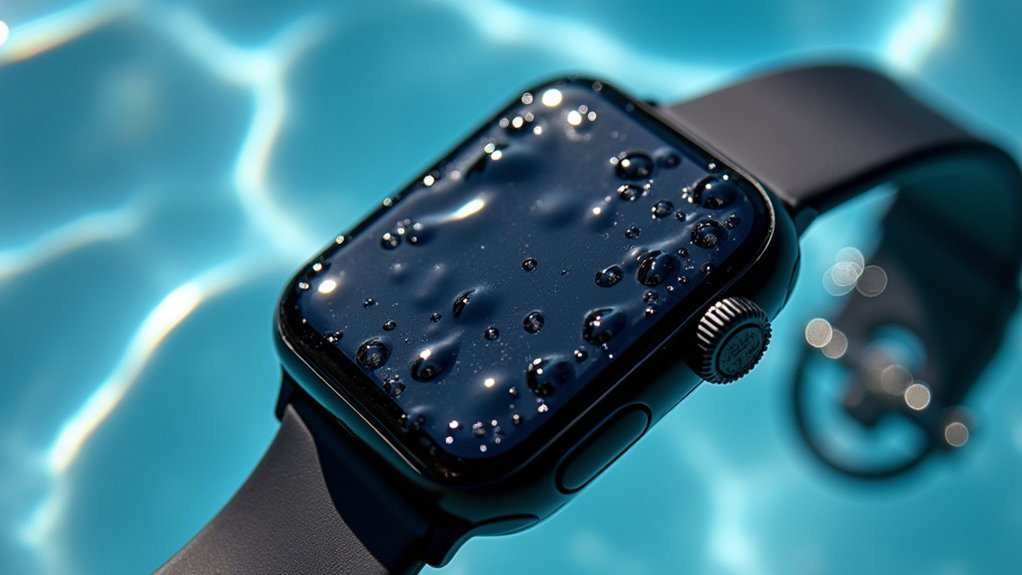
You’ll find that screw-down crowns add an extra layer of protection beyond your watch’s basic water resistance rating.
When you’re swimming, this crown design compresses the O-ring seals more securely and prevents accidental crown activation that could compromise your watch’s watertight seal.
The mechanism also shields your crown from physical impacts during active water sports, giving you greater confidence whether you’re doing laps in the pool or swimming in choppy ocean conditions. Unlike push/pull crowns that can pop out underwater, screw-down designs maintain their sealed position until deliberately unscrewed.
Crown Sealing Mechanism Basics
When evaluating swimming watches, crown sealing mechanisms play an essential role in determining how well your timepiece will perform underwater.
The screw-down crown design, pioneered in 1926 by Perregaux and Perret, screws tightly into your watch case to create a superior seal against water and dust ingress.
You’ll operate it by pushing the stem into the case and winding clockwise until it locks securely. This mechanical locking system prevents liquids and contaminants from entering your watch’s internal mechanism when properly secured.
Unlike push-pull crowns that rely solely on gasket seals, screw-down crowns provide an additional layer of protection.
They’re particularly effective at withstanding external water pressure during active swimming, making accidental crown displacement nearly impossible when you’re moving through water. Many watches with screw-down crowns feature double seals for added protection and minimize crown stem movement, enhancing seal integrity.
Water Pressure Protection Benefits
While screw-down crowns don’t magically increase your watch’s maximum depth rating beyond what push-pull designs can achieve, they deliver vital protection where it matters most during swimming activities.
You’ll find that both crown types can reach identical laboratory ratings like 100m or 200m, but screw-down designs excel under real-world conditions.
The threading mechanism creates mechanical security that prevents accidental crown displacement during dynamic water exposure.
When you’re swimming vigorously or diving, the crown stays locked in position, maintaining gasket compression and alignment.
This reliability becomes important during rapid water movement or when your watch snags on objects.
You’re getting dual assurance: the same depth capability with enhanced sealing security that protects against user error—the most common cause of water damage. However, regular gasket changes every 3-5 years remain essential for maintaining reliable water resistance regardless of crown design.
Swimming Safety Improvements
The threading mechanism transforms your swimming confidence by eliminating the most common source of water damage—accidental crown displacement.
You’ll notice how screw-down crowns provide tactile and visual confirmation that your watch is properly sealed before entering water. This design prevents the crown from being knocked or snagged during vigorous swimming activities, protecting your watch’s internal seals from compromise.
Many swimmers and divers won’t consider watches without screw-down crowns for serious water activities, despite equivalent water resistance ratings.
You’ll experience psychological reassurance knowing your crown can’t accidentally open mid-swim. The threaded design isolates your crown stem more effectively, reducing mechanical strain from impacts. The crown-stem hole represents the weakest point for water penetration in most watch designs.
While push-pull crowns can achieve similar water resistance, you’ll find screw-down mechanisms offer superior protection against the unpredictable forces encountered during swimming.
200m+ Ratings for Serious Swimming and Water Sports
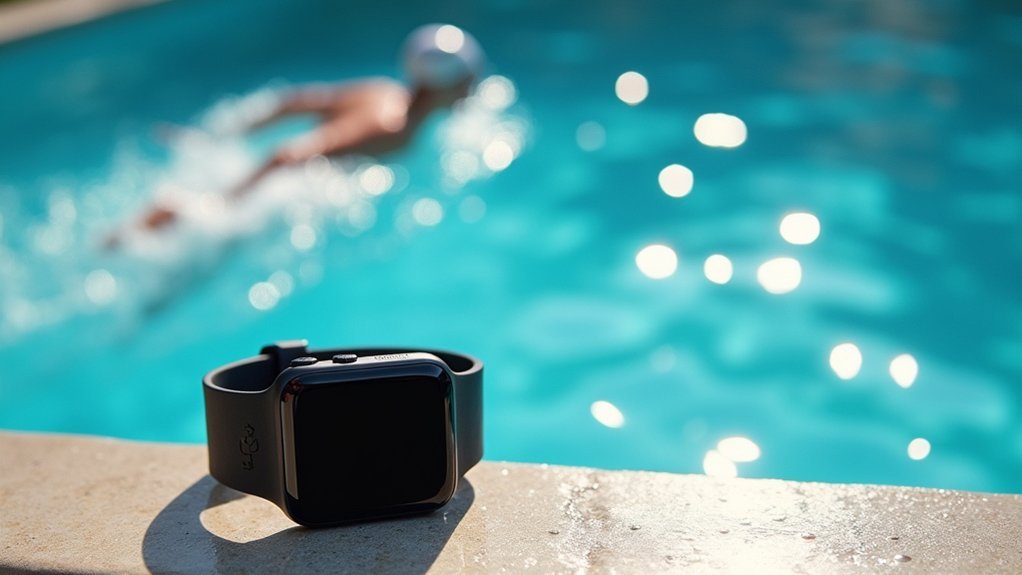
For serious swimming and competitive water sports, you’ll need a watch with at least a 50m water resistance rating, though this represents the absolute minimum threshold rather than an ideal choice.
A 50m rating handles swimming and cold showers but won’t survive hot showers or diving activities. You’ll want 100m for swimming and snorkeling, while 200m opens up diving opportunities.
Remember that these ratings reflect static pressure testing, not the dynamic forces you’ll encounter during actual swimming. Most manufacturers test watches using air pressure in controlled factory environments rather than subjecting them to real-world water conditions.
- 100m+ ratings provide better safety margins for vigorous water activities
- Dynamic pressure from arm movements exceeds static testing conditions
- Seal degradation over time reduces your watch’s actual water resistance
- Temperature changes between water and air can compromise sealing integrity
IP68 Rating Comparison With Traditional ATM Measurements
Beyond traditional ATM ratings, many modern swimming watches now feature IP68 certification—a fundamentally different approach to measuring water resistance.
While ATM ratings measure pressure tolerance (5 ATM equals 50 meters depth), IP68 focuses on specific immersion conditions: up to 1.5 meters deep for 30 minutes maximum.
You’ll find IP68 superior for swimming because it’s more detailed about actual submersion conditions rather than theoretical pressure equivalents.
Unlike 5 ATM ratings, IP68 also guarantees complete dust protection—the first digit guarantees your watch stays dust-tight during beach activities.
For casual swimming and showering, IP68 provides more practical protection specifications.
However, you shouldn’t rely on either rating for extended underwater activities beyond their stated limitations. The IP68 standard is established by the International Electrotechnical Commission to ensure consistent protection measurements across different manufacturers.
Smartwatch Waterproofing Technologies for Athletic Swimming
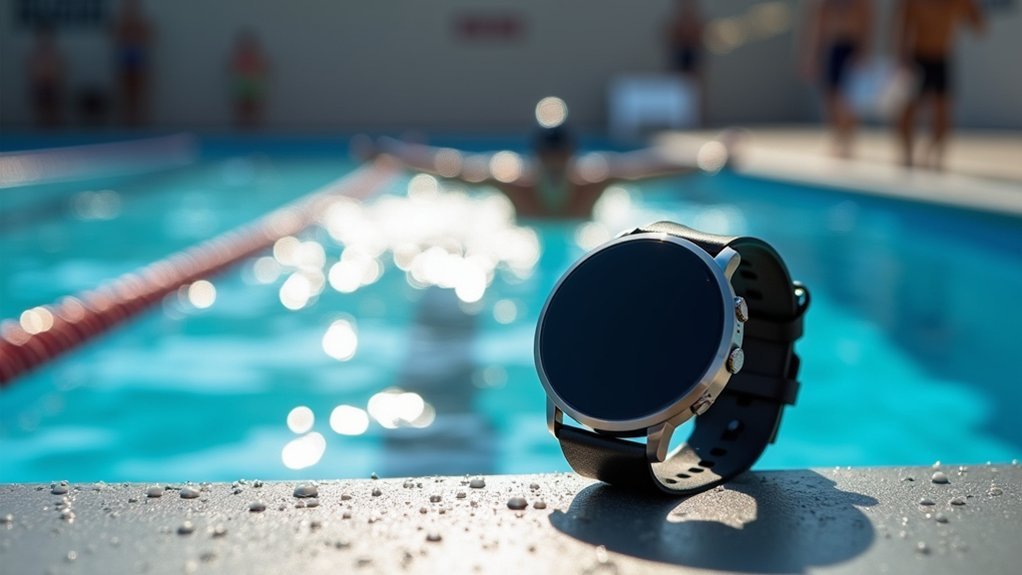
Modern smartwatches designed for athletic swimming incorporate three critical waterproofing technologies that surpass basic water resistance ratings.
You’ll find titanium cases like Samsung Galaxy Watch Ultra’s construction providing exceptional durability against harsh water conditions. Precision-engineered gaskets and seals around buttons maintain protection under dynamic water pressure, while sapphire glass screens resist scratches and reduce water ingress risk.
Advanced corrosion-resistant coatings protect internal components from chlorinated pool water and saltwater damage. These technologies work together to guarantee your smartwatch withstands rigorous swimming sessions. Professional swim watches typically feature 5ATM waterproofing that allows effective tracking during submersion up to 50 meters depth.
- Gasket-protected sensors maintain accurate heart rate monitoring while submerged
- Water-activated swim modes disable non-essential functions to conserve battery
- Physical button controls provide reliable operation when touchscreens fail underwater
- Automatic workout detection minimizes manual interaction during swimming sessions
Manufacturer Guidelines for Swimming With Different Water Resistance Levels
While advanced waterproofing technologies enable smartwatches to survive rigorous swimming conditions, you’ll need to understand your watch’s specific water resistance rating and follow manufacturer guidelines to avoid damage.
Watches rated at 30 meters handle only light splashes and rain—swimming isn’t recommended and may void your warranty. At 50 meters, you can shower and swim briefly in shallow water, but avoid prolonged submersion or high-impact activities.
The 100-meter rating suits recreational swimming and snorkeling perfectly, offering reliable protection for surface water sports. For serious diving beyond recreational depths, you’ll want 200 meters or higher, which includes features like screw-in crowns and helium escape valves for professional underwater activities. Remember that annual testing helps ensure your watch maintains its water resistance capabilities over time.
Frequently Asked Questions
Does Water Temperature Affect My Watch’s Water Resistance Rating?
Water temperature doesn’t change your watch’s official resistance rating, but it affects seal performance. Hot water and temperature changes can stress gaskets, potentially reducing actual protection below the rated level.
How Often Should I Replace Gaskets to Maintain Swimming Safety?
You should replace your watch gaskets every 2-3 years for regular use, but annually if you’re swimming frequently. Always replace them after battery changes or repairs to maintain water resistance.
Can I Shower With My 100M Rated Watch Safely?
You can shower with your 100M rated watch, but it’s not recommended. Chemicals, soap, and sudden pressure changes from showerheads can compromise gaskets and affect water resistance over time.
Will Saltwater Damage My Watch More Than Chlorinated Pool Water?
Yes, saltwater will damage your watch more than chlorinated pool water. Salt accelerates corrosion, dries seals faster, and leaves harder-to-remove residue that causes pitting and discoloration on metal components.
Should I Press Buttons Underwater With a 200M Rated Watch?
You shouldn’t press buttons underwater with a 200M rated watch unless it’s specifically labeled “DIVER’S WATCH 200M.” Pressing buttons can compromise seals and allow water ingress, potentially damaging internal mechanisms.
In Summary
You’ll need at least 100m water resistance for safe swimming activities. Don’t trust 30m or 50m ratings—they’re tested under static conditions that don’t account for dynamic pressure from arm movements and water impact. You’re better off choosing 200m+ ratings if you’re serious about swimming or water sports. Always check your watch’s screw-down crown is properly secured, and follow manufacturer guidelines regardless of the rating to protect your investment.

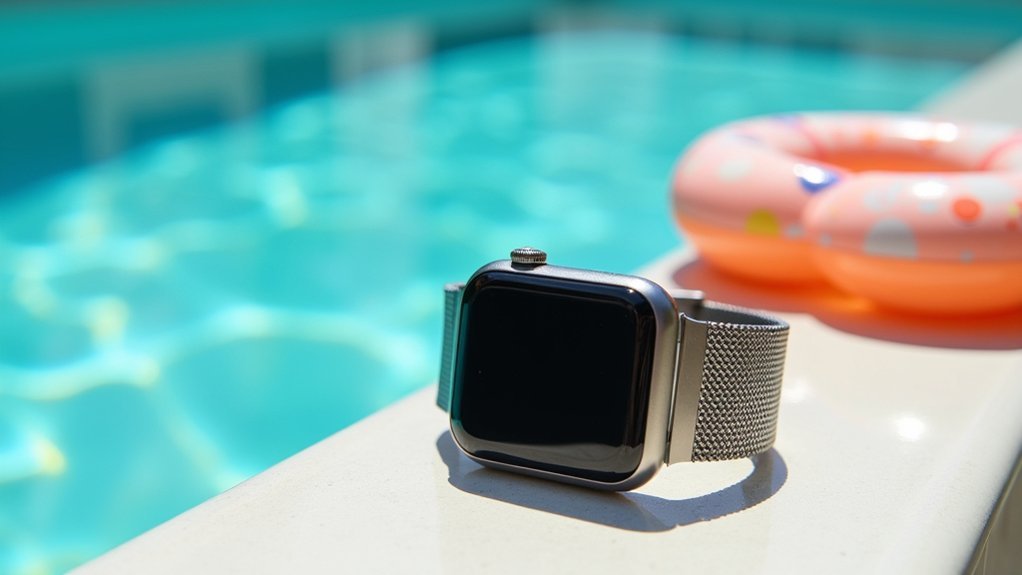



Leave a Reply